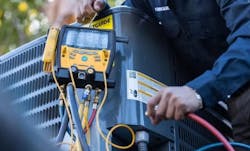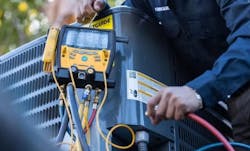Recovering, Recycling and Reclaiming Refrigerants in Heat Pumps
As HVAC professionals, we all play a role in combating climate change. One important way is to safely recover, recycle and reclaim all refrigerant from a system.
How much of an impact will we have by doing this? One pound of leaked HFC has the same impact on the atmosphere as thousands of pounds of carbon dioxide. While it may be heating season now, the proliferation of heat pump installations to both heat and cool interiors highlights the critical importance of the “three R’s” year-round.
What the A1 Phaseout and A2L Adoption Mean
Because commonly used refrigerants are potent greenhouse gases, the EPA is phasing out those with a high global warming potential (GWP) in most new equipment starting January 1, 2025. These discontinued A1 refrigerants include R134a, R404A and R410A.
Your diligence in recovering, recycling, and reclaiming these refrigerants not only limits their release into the atmosphere but it helps ensure an adequate supply of reclaimed refrigerants to service the installed base of A1 systems. The production phasedown of today’s major refrigerants will inevitably increase charging costs, but full participation in recycling and reclaiming will help mitigate the rise in costs – saving your customers money.
The phasedown of A1 refrigerants is leading to the adoption of A2L refrigerants, such as R-32 and R454B, which have a low toxicity and low GWP. A2L refrigerants are mildly flammable compared to A1’s, however they are still difficult to ignite with a relatively low energy release and low flame propagation speed. When installing or servicing an A2L system, it is important to ensure that your service tool and test equipment is A2L compatible prior to handling A2L refrigerants.
How to Safely Recover Refrigerant
Before handling refrigerant, be sure to wear the appropriate PPE, such as gloves, safety glasses, and impermeable clothing. Liquid refrigerants can cause frostbite so it’s paramount to avoid skin contact.
When recovering refrigerant, you will want to identify the refrigerant type on the compressor unit and ideally select your recovery cylinder to match for recycling purposes. Find the cylinder capacity on the tank and calculate the maximum fill weight, which should be 80% of the total capacity for safety. Weigh your initial cylinder weight on a refrigerant scale and determine how much refrigerant can be added to the tank from the system. The Fieldpiece SR47 refrigerant scale allows you to monitor both the total tank weight and the added refrigerant weight during the recovery process.
Read the MR45: Refrigerant Best Practices blog to learn more tips for a smooth recovery. For recycling and reclaiming purposes, remember to document your final recovered refrigerant weight.
Recycled vs. Reclaimed Refrigerant
You may use recycled refrigerant, meaning used refrigerant that has undergone a basic, on-site cleaning process with certified equipment, only on the same job site. Note that recycled refrigerant cannot be stored on-site for more than 12 months. There are many regulations that HVAC technicians must follow when recycling refrigerants including Section 608 of the Clean Air Act. Make sure your team stays current on training and certification. Typically, your local HVAC supply house will accept drop offs of recovered refrigerant cylinders and submit them to a certified reclaimer.
Refrigerant reprocessed by a certified reclaimer to the industry standard AHRI 700 is considered reclaimed refrigerant. A reclaimer will clean the refrigerant and remove any moisture or toxic particles. They’ll also separate any oil or additives from the refrigerant and dispose of contaminants. Reprocessed refrigerants meet or exceed purity standards for new refrigerant gases and reprocessing will become increasingly more important as the new production of A1 refrigerants is phased down.
The first step to make sure we’re protecting and preserving our planet lies with you, HVACR pros. Recovering refrigerant lies squarely in your hands and we can work together to ensure the proper equipment is used and processes are followed to ensure a steady supply of recycled and reclaimed refrigerant is readily available for the years to come.
The author, Tony Gonzalez, is the Technical Training Manager for Fieldpiece Instruments.
About Fieldpiece
Fieldpiece Instruments is an innovative technology company focused on helping industry professionals do their jobs more easily, faster and better around the globe. It delivers on this promise through industry-leading devices with the broadest range of professional-grade tools and technology inspired by real-world application and field use. Fieldpiece is focused on serving the HVACR industry exclusively, enabling HVACR professionals to become Masters of the Trade. For more information, please visit www.fieldpiece.com, and be sure to follow Fieldpiece on Facebook, Instagram, YouTube and LinkedIn.
About the Author
Tony Gonzalez
Technical Training Manager
Tony Gonzalez is Technical Training Manager at Fieldpiece Instruments (www.fieldpiece.com).
He has more than 20 years of industry experience with Fieldpiece developing new products. Most recently, he led the Job Link® App development team and developed Fieldpiece’s wireless power clamp meters. He is committed to training on best practices to help the HVACR professional do their job easier, faster and better.
Tony enjoys road cycling and rooting for his hometown LA Dodgers.

